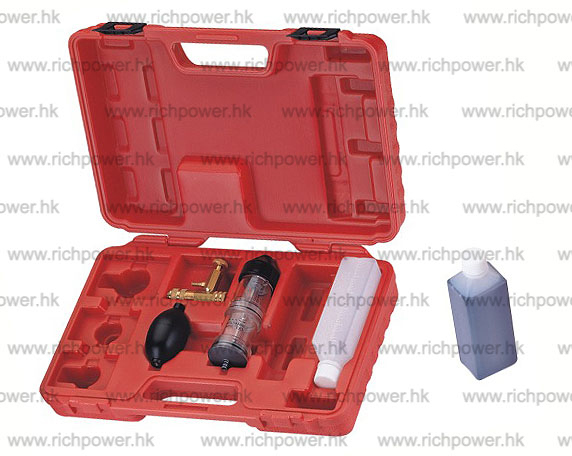LEAK-CHECK FOR COMBUSTION
This test kits is used for checking volume of CO2 existed in radiator in the car. Have blue color of test liquid mixed with stem in the radiator. If the liquid become yellow then it means that the wall of cylinder is abrasive. Thus, the exhaust gas inside the cylinder can not be all come out from the exhaust pipe and some of them flowed with coolant into the radiator. Then, then temperate inside the radiator is getting up.
TEST PROCEDURES:
1. Pump up approximately 1/10 volume of coolant from the radiator (see Fig.1)
2. Fill test liquid into the top of checking cup (below the marking line).
3. Start engine and get the coolant circulated to create steam.
4. As shown on Fig.2, put test kits on the filler of radiator to pump steam
from the radiator through the ball. The cup in the bottom of test kits is
used as a steam filter.
from the radiator through the ball. The cup in the bottom of test kits is
used as a steam filter.
5. As shown on Fig.3, connect the tester of radiator with quick coupling
then pump steam from the radiator through the ball. This is a close
connection which no air in outside of the radiator is pumped so the test
result is more accurate.
then pump steam from the radiator through the ball. This is a close
connection which no air in outside of the radiator is pumped so the test
result is more accurate.
6. Use the way as shown on Fig.4 but without pumping air through the ball.
Have the steam coming automatically from the radiator mixed with the test liquid.
Have the steam coming automatically from the radiator mixed with the test liquid.
7. Once the test is finished, pump air several times from outside through
the ball then mixed with the liquid. Then, the test liquid returns to blue
and can be kept for test in future (Fig,5).
the ball then mixed with the liquid. Then, the test liquid returns to blue
and can be kept for test in future (Fig,5).
WARNING: During test, the temperature of radiator is getting hot
so the operator should be careful and keep it away.

so the operator should be careful and keep it away.

11
11



